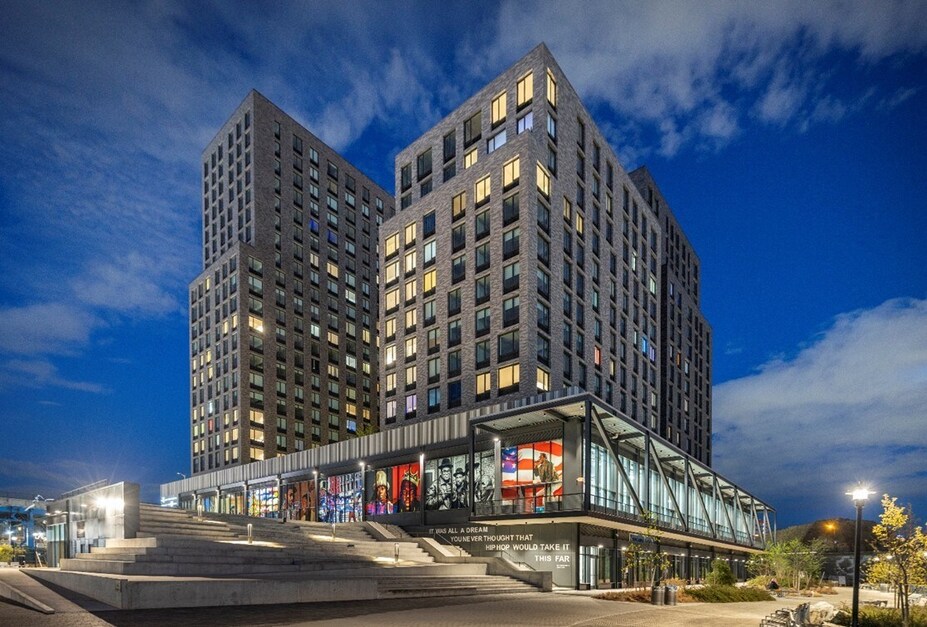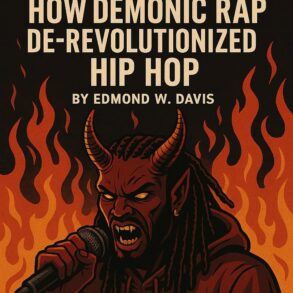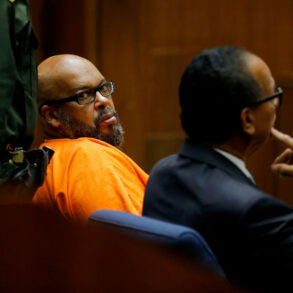The groundbreaking project, expected to drive foundational and enduring economic development in the South Bronx, marks NJCC’s expansion to funding transformative projects beyond New Jersey
NEW BRUNSWICK, N.J., May 7, 2025 /PRNewswire/ — New Jersey Community Capital (NJCC), a leading national community development financial institution, today announced it closed an $8.5 million New Market Tax Credit (NMTC) loan to The Hip Hop Museum (THHM) in New York City’s the Bronx. As the first global museum dedicated to documenting, educating, preserving and celebrating Hip Hop history and culture and the anchor of the new mixed-use development Bronx Point, THHM is poised to attract millions of visitors in coming years and be a catalyst for transformative economic development. The NMTC allocation is a significant achievement for NJCC, marking the expansion of its mission beyond New Jersey and its skill at executing innovative projects in overlooked communities.
Photo Credit: The Hip Hop Museum
“We strive to support projects that will make a substantial impact on their communities and residents, as well as spur the most broad and lasting economic development possible. Right now, this is especially critical in the Bronx, where New York City’s annual Poverty Tracker recently reported substantially higher disadvantage rates than every other borough,” NJCC President and CEO Bernel Hall said.
“Given the sweeping depth, breadth and cultural significance of the museum and its location in the heart of the Bronx’s urban landscape and near Yankee Stadium, we know it will drive the foundational and enduring economic development of the borough in many ways,” Hall continued. “For example, THHM’s attendance is anticipated to attract over a million visitors annually from not only across America but worldwide, which will substantially increase tourism-related revenue for local businesses.”
But perhaps most significant will be THHM’s role in enriching the cultural fabric of the local community. “The museum will stimulate sustained growth as its operations expand, leading to further investment in the area. While Hip Hop is undeniably a global force, its origins are right in the heart of the Bronx,” said Hall. “The Hip Hop Museum not only honors that legacy, but it’s investing back into the community. I’m honored to support THHM’s mission to ‘preserve the past and celebrate the present,’ continuing to make the Bronx a place where people are proud to live, work and raise their families.”
The Hip Hop Museum’s Journey Home to the South Bronx
Providentially, The Hip Hop Museum’s new South Bronx home reflects its origin story: According to narratives documented in many sources that include Harvard University’s Hiphop Archive & Research Institute and multiple news outlets, hip-hop music originated at DJ Kool Herc’s sister’s party in the Bronx on August 11, 1973, when he used two turntables to extend the “breaks” of funk songs and allow longer dance instrumentals. The stirrings of a global phenomenon emerged against a backdrop of the Bronx in crisis: In the wake of the Civil Rights Movement, racial tensions, rising poverty and redlining plagued the community, and a wave of fires devastated entire neighborhoods. Yet, out of these hardships, young people created a movement grounded in self-expression, resistance, story-telling and community pride.
At that time, THHM CEO Rocky Bucano, born in Spanish Harlem but raised and still living in the Bronx, was a teenager working as a local DJ and went on to become an arts and educational entrepreneur. He remained active in Hip Hop culture, continuing to work and collaborate with celebrated Hip Hop entrepreneurs and artists. Bucano went on to help found THHM, the first Hip Hop museum in the Bronx, with Kurtis Blow, Grand Wizzard Theodore, Grandmaster Melle Mel and Joe Conzo Jr..
“By then, Hip Hop was so much more than just a music genre. It had not only shaped identity, expression, art and technology for my generation—and inspired an entire industry with countless business opportunities—it had also made an indelible impact on younger generations and continues to do so to this day. It’s an international cultural force, so we believed it was critical to celebrate its global evolution, and educate and empower younger generations on its meaning and potential to enrich their lives. The museum also revitalizes its birthplace, the Bronx, with a permanent place to celebrate Hip Hop history and culture and house resources that can drive positive social change. That includes a research center, a permanent living archive, educational programming and career and leadership training,” Bucano explained.
“We connected with several real estate developers about different opportunities, but nothing materialized until we teamed up with L&M Development Partners back in 2016 with a superb proposal for a 585,000 SF mixed-use development along the once-underutilized Harlem River waterfront. Our aspirations quickly went from a dream to reality, and for good reason,” Bucano explained. “L+M’s proposal embraced a holistic, community-inclusive approach that had all the resources needed to spark catalytic transformation.”
Inspiring a Cultural and Economic Renaissance
With 542 permanently affordable housing units, an almost three-acre waterfront park and retail and community spaces, Bronx Point has quickly and effectively lived up to its promise. “People started moving into the apartments at the end of 2023, and the community is already deep in the throes of transformation,” Bucano pointed out. “Besides THHM and a K-12 charter school in development in Bronx Point, new schools, cultural assets, shopping areas and housing projects are going up all around us.”
“These projects are in direct alignment with NJCC’s and THHM’s tenets to support, nurture and engage communities and help them realize far-reaching economic, educational and cultural revitalization,” Hall noted. New or revitalized projects in the South Bronx contributing to this renaissance include the Bronx Civic Center, the Bronx Music Hall, the Bronx Documentary Center and at least four new charter schools, as well as the relocation of Great Performances, the largest woman-owned food service company in NYC.
Financing The Hip Hop Museum
Monge Capital, which provides capital solutions and advisory services for real estate projects and operating businesses, structured the $8.5 million NMTC investment. “We focus on public-private partnerships and community development initiatives that bring capital to overlooked communities and make significant economic impact. I was born and raised in the Bronx and grew up immersed in hip-hop culture. I recognized the enormous potential of this project immediately, and just as quickly I knew NJCC would be the perfect partner for this opportunity because we share the same mission and they’re creative and flexible,” Monge Capital managing partner Jeff Monge said. “Those are important qualities when you’re working with a unique borrower with imaginative ideas of their own.
“Still, it took us five years to structure the deal, which also included Dudley Ventures, a financial services firm owned by Valley National Bank. [In Public Enemy’s song, ‘Welcome to the Terrordome’] Chuck D says ‘I got so much trouble on my mind, I refuse to lose’–this stuck with me. The importance of this transaction for the community [is what] kept me going, as well as my kids’ reaction to the project. They’ve never focused much on my projects, but they are wildly impressed with this project and can’t wait to visit the museum when it’s done,” Monge admitted.
When THHM opens in Summer 2026, it will not only honor one of the most influential movements in modern history, but it will also be “a wildly forceful economic and cultural catalyst,” he added.
“With its immersive exhibitions, educational offerings and community engagement programs, it will attract people of all ages because hip-hop devotees span a wide range of generations,” Bucano pointed out. “Its founders are now in their late 60s and early 70s—even DJ Kool Herc—while some of the most influential hip-hop artists today are in their 20s and 30s, from Doechii (25), Central Cee (27) and Ken Carson (25) to Kendrick Lamar (37) and Young Thug (33).”
“Because of the diverse, evolving and intellectually important nature of Hip Hop, and the genre’s rich offerings that touch so many cultural benchmarks, this is a formative project that will have deep-rooted staying power. It will inspire curiosity, creativity, innovation and empowerment locally and globally for generations to come,” Hall said.
About New Jersey Community Capital
New Jersey Community Capital is a nonprofit community development financial institution dedicated to advancing opportunity through strategic investments and knowledge-based programs. It finances and supports individuals, businesses, educational organizations and communities; preserves and develops affordable housing, community facilities and educational organizations; and creates sustainable economic development that generates quality jobs, improves education and strengthens neighborhoods to ensure that communities can thrive. Founded in 1987, NJCC has grown to serve as a critical architect of community development initiatives, driving economic stability and wealth generation in overlooked areas.
Editor’s note: In this release, “Hip Hop” refers to the broader cultural movement, while “hip-hop” is hyphenated only when referencing specific elements of the culture—such as hip-hop music or hip-hop dance. This distinction is intentional and reflects how many cultural leaders and institutions recognize Hip Hop as more than just music—it’s a global, generational force.
LinkedIn: @new-jersey-community-capital.
Media Contacts:
John Hiltner
[email protected]
SOURCE New Jersey Community Capital

This post was originally published on this site be sure to check out more of their content.







